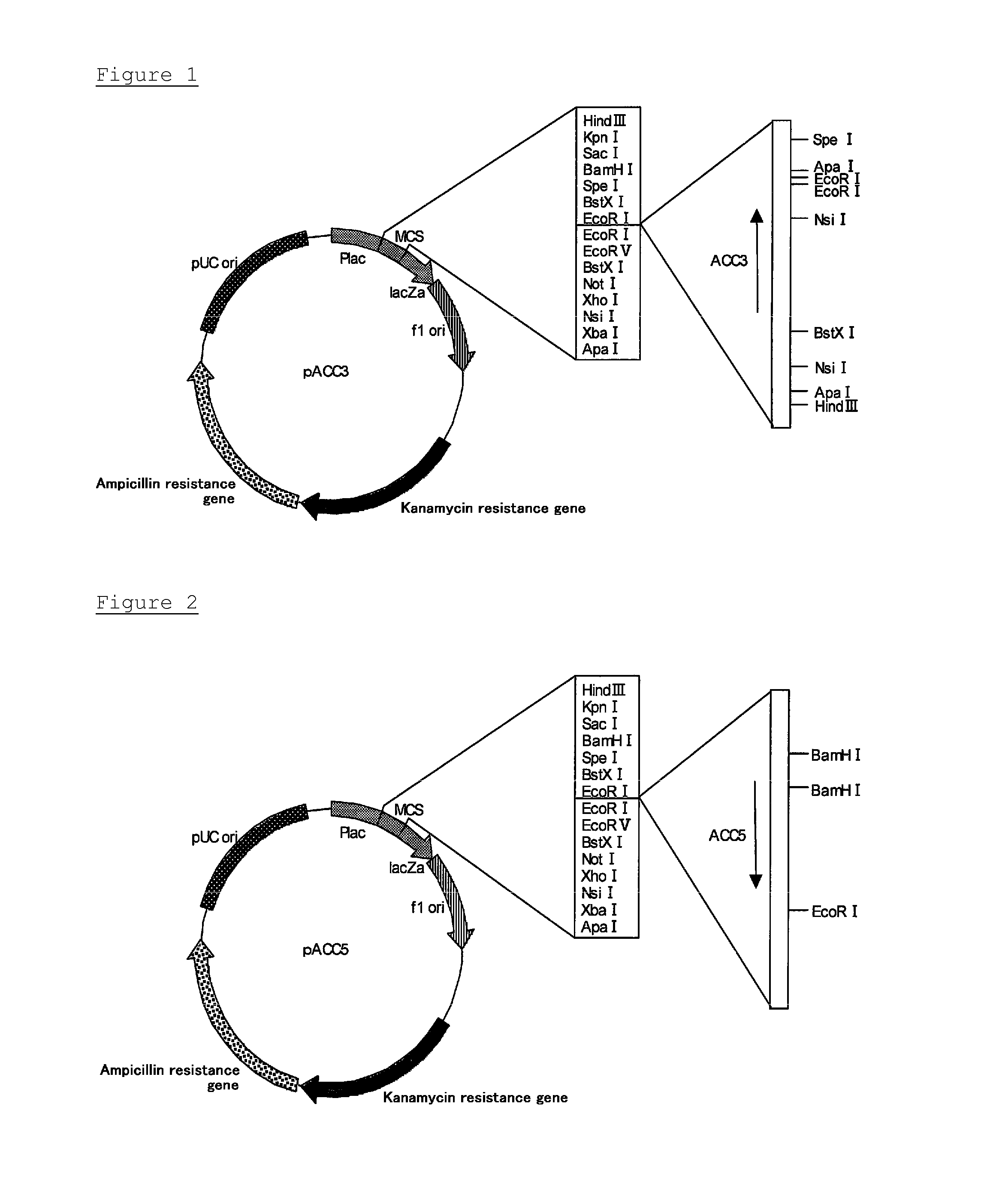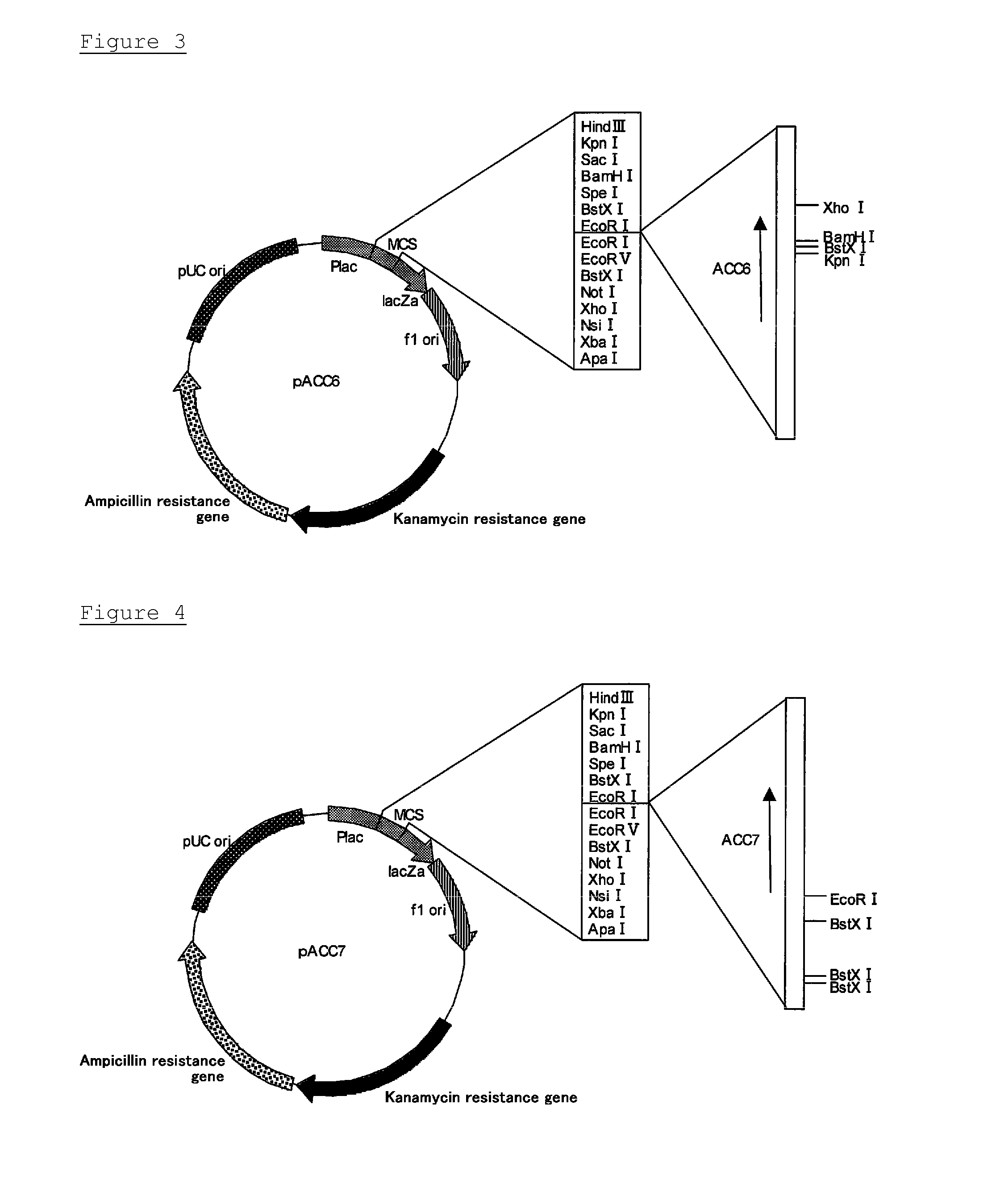Novel cellulase gene
- Summary
- Abstract
- Description
- Claims
- Application Information
AI Technical Summary
Benefits of technology
Problems solved by technology
Method used
Image
Examples
example 1
(1-1) Isolation of Genomic DNA
[0073]Acremonium cellulolyticus ACCP-5-1 was cultivated in an (s) medium (2% bouillon, 0.5% yeast extract, and 2% glucose) at 32° C. for 2 days, and centrifuged to collect mycelia. Genomic DNA was isolated from the obtained mycelia in accordance with the method of Horiuchi et al. (H. Horiuchi et al., J. Bacteriol., 170, 272-278, (1988)).
(1-2) Cloning of ACC3 Gene Fragment
[0074]The following primers were prepared based on the sequences of known endoglucanases which were classified into Glycoside Hydrolase family 5.
ACC3-F:GGGCGTCTGTRTTYGARTGT(SEQ ID NO: 19)ACC3-R:AAAATGTAGTCTCCCCACCA(SEQ ID NO: 20)
[0075]PCR was carried out using ACC3-F and ACC3-R as primers and genomic DNA as a template, and using LA Taq polymerase (Takara Bio). The PCR was carried out by repeating a cycle consisting of a reaction at 94° C. for 30 seconds, annealing for 30 seconds, and a reaction at 72° C. for 1 minute 40 times. The annealing temperature was lowered st...
example 2
[0085](2-1) Isolation of Genomic DNA and mRNA and Preparation of cDNA
[0086]Genomic DNA of Acremonium cellulolyticus ACCP-5-1 was isolated in accordance with the method described in Example 1-1. cDNA of Acremonium cellulolyticus ACCP-5-1 was prepared in accordance with the method described in Example 1-4
(2-2) Cloning of ACC5 Gene Fragment
[0087]The following primers were prepared based on the N-terminal amino acid sequences of known endoglucanases which were classified into Glycoside Hydrolase family 7 and the poly A nucleotide sequence.
(SEQ ID NO: 27)ACC5-F: CAGCAGGCCCCCACCCCNGAYAAYYTNGC(SEQ ID NO: 28)ACC5-R: AATTCGCGGCCGCTAAAAAAAAA
[0088]PCR was carried out using ACC5-F and ACC5-R as primers and cDNA as a template, and using LA Taq polymerase (Takara Bio). The PCR was carried out by repeating a cycle consisting of a reaction at 94° C. for 30 seconds, annealing for 30 seconds, and a reaction at 72° C. for 1 minute 40 times. The annealing temperature was lowered ste...
example 3
Cloning of ACC6 Gene
(3-1) Isolation of Genomic DNA and Preparation of Genomic Library
[0097]Genomic DNA of Acremonium cellulolyticus ACCP-5-1 was isolated in accordance with the method described in Example 1-1. The isolated genomic DNA was partially digested with Sau3AI. The resulting product was ligated with BamHI arms of a phage vector dMBL3 cloning kit (Stratagene) using a ligation kit Ver. 2 (Takara Shuzo). The ligation mixture was subjected to ethanol precipitation, and the resulting precipitate was dissolved in a TE buffer. Phage particles were formed using the ligation mixture solution and a MaxPlax λ packerging kit (Epicenter Technologies), and Escherichia coli XL1-blue MRA(P2) was infected with the phage particles. A genomic DNA library of 1.1×104 phages was obtained by this method.
(3-2) Cloning of ACC6 Gene Fragment
[0098]The following primers were prepared based on the sequences of known endoglucanases which were classified into Glycoside Hydrolase family 5.
(SEQ ID NO: 35)A...
PUM
| Property | Measurement | Unit |
|---|---|---|
| Fraction | aaaaa | aaaaa |
| Digestibility | aaaaa | aaaaa |
Abstract
Description
Claims
Application Information
 Login to View More
Login to View More - R&D
- Intellectual Property
- Life Sciences
- Materials
- Tech Scout
- Unparalleled Data Quality
- Higher Quality Content
- 60% Fewer Hallucinations
Browse by: Latest US Patents, China's latest patents, Technical Efficacy Thesaurus, Application Domain, Technology Topic, Popular Technical Reports.
© 2025 PatSnap. All rights reserved.Legal|Privacy policy|Modern Slavery Act Transparency Statement|Sitemap|About US| Contact US: help@patsnap.com



